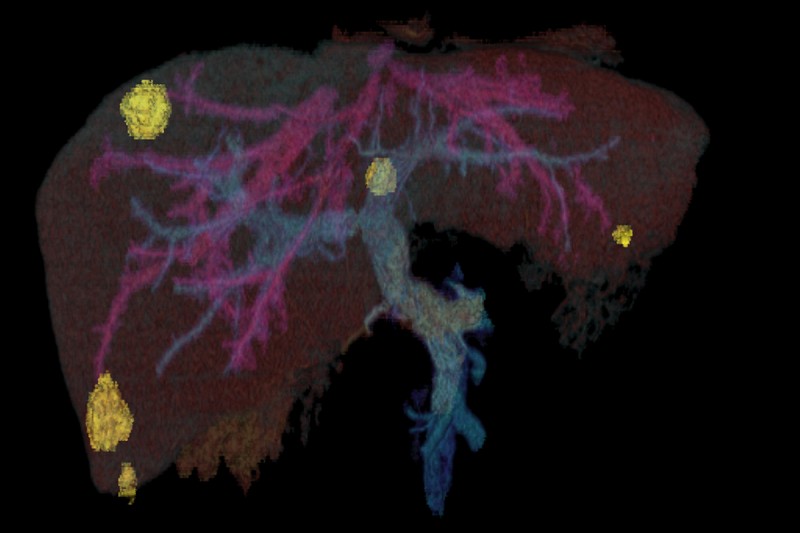
The largest retrospective study ever done on a chemotherapy delivery approach called hepatic arterial infusion (HAI) has shown that this treatment extends survival by about two years when used in addition to systemic chemotherapy. Published in the Journal of Clinical Oncology (JCO), the study looked back at patients who were able to undergo surgical removal of colorectal cancer that had spread to the liver. It included patients treated at Memorial Sloan Kettering over a 20-year period.
“This is not a treatment that many other hospitals are using,” says study co-author Nancy Kemeny, an MSK medical oncologist who helped develop the current procedure for using HAI and who has been a proponent of the therapy for decades. “We get patients coming here from all over because they’ve heard about our expertise with this treatment.”
Colon and rectal cancers, which together affect more than 135,000 people in the United States every year, are often curable when caught early, but when they spread, they are much more difficult to treat.
Priming the Pump
HAI employs a pump about the size and shape of a hockey puck that’s surgically implanted in the abdomen and delivers chemotherapy directly to the liver. The pump is placed under the skin between the ribs and pelvis. It is then connected to the hepatic artery, which supplies blood to the liver, and especially to liver tumors. The pump is usually inserted at the same time a patient has surgery to remove tumors in the liver. HAI is called an adjuvant treatment, and it provides a way to offer extra cancer-fighting power and eliminate any residual disease.
The pump also may be used to try to shrink large tumors or reduce the number of tumors, with the hope that they can then be surgically removed. Patients who receive chemotherapy through the pump also get systemic treatments, such as chemotherapy and targeted therapies, given by IV.
Providing a Survival Advantage
The JCO study looked at all the patients who underwent surgery at MSK between 1992 and 2012 to remove liver metastases from colorectal cancers — 2,368 people in total. Analysis showed that the median survival for patients who received the adjuvant HAI therapy was 67 months, versus 44 months for those who had standard systemic chemotherapy alone. Five-year survival was 53% in the pump group compared with 38% in those who got systemic chemotherapy alone. Ten-year survival rates were 38% and 23%, respectively.
“What’s especially noteworthy about this study is that the patients who got the HAI pump tended to be worse off before the treatment,” says MSK surgeon Michael D’Angelica, the senior author of the study. “They were sicker overall and had a greater number of metastases. Yet they still had a survival that was, on average, almost two years longer.”
The reported five-year survival in this study takes into account all the patients who underwent liver surgery for colorectal metastases during the 20-year period, but since 2003, there have been new systemic chemotherapy agents developed that have further improved survival. Another study conducted by Dr. Kemeny, which was recently published in the Journal of Surgical Oncology, reported an overall five-year survival of 78% for patients whose treatment plans included HAI plus the newer systemic chemotherapy agents after liver surgery.
Dr. D’Angelica adds that because the chemotherapy in the pump is completely taken up by the liver, there are no significant additional side effects. “The drugs from the pump are biochemically isolated in the liver, which allows us to give them in combination with other systemic drugs,” he says.
Spreading the Word
Recently, medical and surgical oncologists from several institutions throughout the United States and Europe have visited MSK to learn about HAI pump therapy. They spent time with Dr. Kemeny and the hepatobiliary surgeons in the clinic and operating room to learn how to manage the pump. “These physicians from other centers are now starting pump programs at their own institutions,” Dr. Kemeny says.
One big caveat to the study’s findings, Dr. D’Angelica says, is that in order for the HAI pump to become part of the standard of care, it would need to be studied in a controlled, randomized trial comparing the two regimens. “The findings are exciting because the differences in outcome are not small, and they are not subtle,” he says. “The evidence is about as strong as you can get without doing a randomized trial.”
The HAI pump is also being studied in intrahepatic cholangiocarcinoma, a type of cancer originating in the liver that is becoming more common. “We see a doubling of response rate in patients with unresectable disease who also get the pump versus those who get systemic chemotherapy alone,” Dr. D’Angelica says. MSK is currently studying this treatment in a phase II trial.





